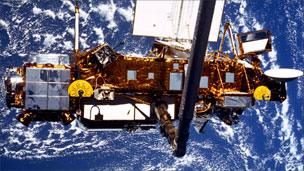Who, What, Why: Can you dodge a falling satellite?
- Published

The UARS was launched in 1991 by the Space Shuttle Discovery
Fragments from a satellite falling to Earth are expected to land on Friday. So is it possible to take evasive action?
A six-tonne satellite is expected to crash land in the next 24 hours, scattering debris over an area of the planet's surface up to 500km (310 miles) wide.
Nasa, which owns the Upper Atmosphere Research Satellite (UARS), estimates it will break into about 26 parts, the heaviest weighing about 158kg, which is equivalent to a very large person.
The debris will include three batteries, four wheel rims and four fuel tanks, external, and their speed when they hit the ground or the ocean will vary.
The rims, for example, could reach speeds of 107 metres per second (240mph), which is faster than one of France's high-speed TGV trains and 10 times quicker than Usain Bolt.
So is it possible for humans to ensure they don't get hit?
"Potentially, you could get out of the way," says Richard Crowther of the UK Space Agency, which is a member of a global network of agencies that monitors space debris, external.
"But if you're going to spend all the time looking up then you're at greater risk of an accident bumping into something than something coming down on you."
Equally, if you want to avoid the risk of being hit completely, he says, then you need to go beyond 57 degrees latitude north (Scotland or Quebec) or south (further south than the southern tip of Argentina).
"But travelling there will involve a greater risk than the risk of being hit by this."
Even if it is coming to your neighbourhood, you won't get much notice.
Nasa is tracking the object in orbit and said on Thursday that it was expected to re-enter the atmosphere on Friday, external afternoon on the US east coast (evening in the UK, which is five hours ahead).
But Nasa doesn't know where it will land, partly due to continuous changes in the atmosphere caused by the Sun. And the uncertainty surrounding the satellite's final destination will continue until its final minutes.
In 1979, when the Skylab space station fell to Earth, it missed the expected landing in South Africa and crashed in Western Australia.

People are not going to need to duck and weave, says Victoria Samson, a space expert at the Secure World Foundation in Washington, DC.
"It's not really coming straight down but rather skimming mostly horizontally through the atmosphere. So you're more likely to see it going by than get hit by it."
It will leave a visible trail, she adds, much like a Russian rocket did when it re-entered the atmosphere in the night skies above Denver, Colorado, external.
"The good news is that the chance of it coming down and hurting someone is pretty slim," says Ms Samson.
"Nasa says there's a one in 3,200 chance that a piece will hit a person somewhere on the planet but for one person specifically the risk is one in 21 trillion."
The planet is hit by debris from space nearly every day, she says, so there's little to fear.
"I understand that the idea of something falling from the sky towards you is very unnerving, but a good chunk of the Earth is covered with water and a lot of the land is unpopulated."
The only person ever to be hit by space debris, as far as we know, was Lottie Williams who was unharmed after being struck on the shoulder by a piece of the Delta II rocket in 1997, while out walking near her Oklahoma home.
It was about 10cm x 13cm and weighed roughly the same as a crushed drinks can. Speaking to the Toronto Sun this week, external, she advised people to go outside if the UARS is coming in their direction, so they can run out of the way.
However, says Hugh Lewis, a lecturer in aerospace engineering at Southampton University in the UK, you are much less likely to see it if it's coming towards you, than if it's flying past.
"What can you do to avoid it? It's the same as you would to avoid anything falling out of the sky - a bird or an aeroplane," he says.
"It could do some damage to a car or house. Anything that's the size of a moped travelling at 35mph would leave a dent.
"Or it could put a hole in a roof but it's much more likely to land on water or where there's no population."
It seems likely that UARS will avoid areas inhabited by humans, but the experience will be something of a dress rehearsal for a greater danger coming in November.
A German satellite telescope called Rosat is expected to re-enter with much bigger pieces, including a very large mirror, still intact.